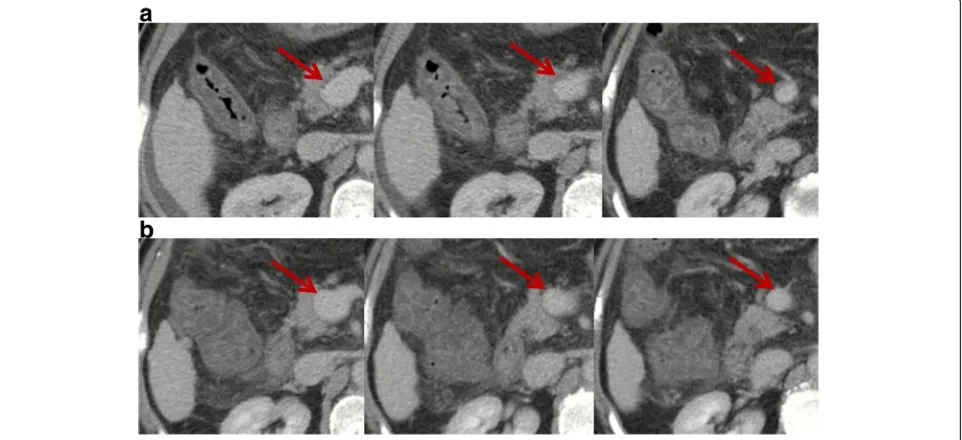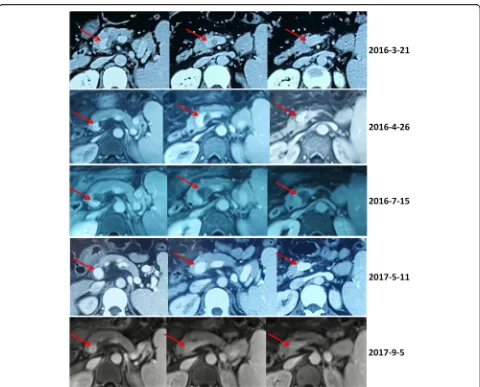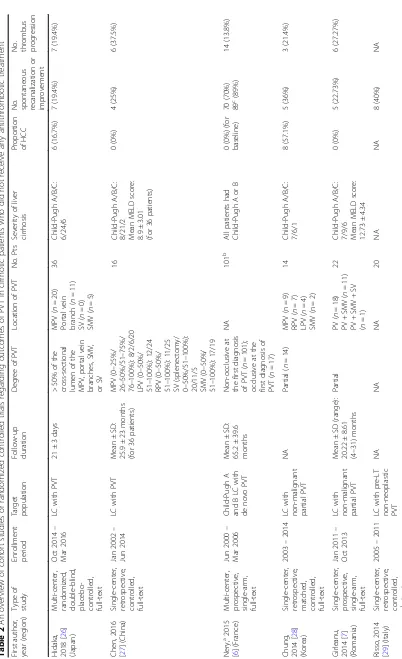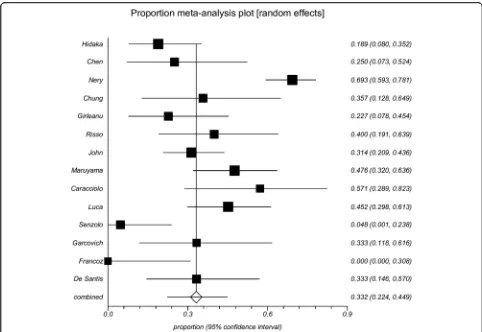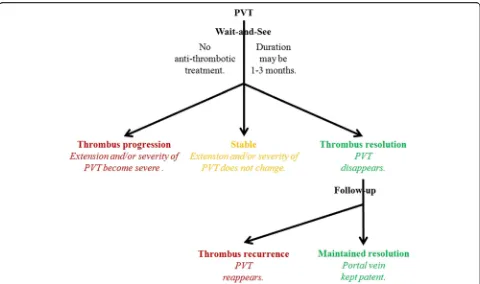M I N I R E V I E W
Open Access
Transient portal vein thrombosis
in liver cirrhosis
Xingshun Qi
1*, Xiaozhong Guo
1, Eric M. Yoshida
2, Nahum Méndez-Sánchez
3, Valerio De Stefano
4, Frank Tacke
5,
Andrea Mancuso
6,7, Yasuhiko Sugawara
8, Sien-Sing Yang
9, Rolf Teschke
10, Ankur Arora
11and Dominique-Charles Valla
12,13Abstract
In real-world clinical practice, the acceptance of anticoagulation therapy in the management of portal vein thrombosis (PVT) in patients with cirrhosis is limited by the fear of an increased bleeding risk. Additionally, accumulating evidence indicates that spontaneous recanalization of PVT may occur in the absence of antithrombotic treatment. Therefore, risk stratification based on outcomes in such patients is crucial for determining a therapeutic strategy. In this paper, we draw attention to the distinct clinical entity,“transient PVT”by introducing two cases with PVT that spontaneously recanalized in the absence of antithrombotic treatment. We reviewed the available data regarding the probability of and predictors for spontaneous recanalization of PVT. Available data suggest singling out transient thrombosis in the natural history of PVT in patients with cirrhosis because of its prognostic and management implications.
Keywords:Portal vein thrombosis, Liver cirrhosis, Recanalization, Anticoagulation, Transient
Background
Anticoagulation therapy for portal vein thrombosis (PVT) may be considered in patients with cirrhosis based on the current practice guidelines and consensus
statements [1, 2]. Indeed, two recently reported
meta-analyses suggest that anticoagulation therapy im-proves the rate of portal vein recanalization and prevents
thrombus progression in such patients [3, 4]. Still, the
actual impact of recanalization on the clinical outcomes remains to be clarified. In real-world clinical practice, the acceptance of anticoagulation therapy for the man-agement of PVT in patients with cirrhosis is limited by
the fear of an increased risk of bleeding [5]. Recently,
spontaneous recanalization of PVT has been reported by several investigators in patients with cirrhosis who did
not receive any antithrombotic therapy [6–10]. Thus,
some patients who develop spontaneous portal vein recanalization can avoid the exposure to anticoagulation and its related risk of bleeding.
There is also evidence that occlusive PVT is associated with a risk of bleeding from portal hypertension and
death in patients with liver cirrhosis [11, 12]. However,
available cross-sectional data do not allow clinicians to determine whether the link is causal. In comparison with occlusive thrombosis, the impact of partial PVT on the prognosis of cirrhosis may be marginal. If this proves to be true, the indication and timing for implementing anticoagulation therapy should be discussed accordingly.
Therefore, stratification along the degree of PVT in pa-tients with cirrhosis could become important for guiding management, including a wait-and-see attitude, anticoagu-lation therapy, or transjugular intrahepatic portosystemic
shunt (TIPS) [13].
Key points
1. Risk stratification of portal vein thrombosis in liver cirrhosis should be widely acknowledged.
2. Spontaneous recanalization of portal vein thrombosis has been frequently observed in liver cirrhosis.
3. Transient portal vein thrombosis should be recognized as a distinct clinical entity in liver cirrhosis.
* Correspondence:xingshunqi@126.com
1Liver Cirrhosis Study Group, Department of Gastroenterology, General Hospital of Shenyang Military Area, No. 83 Wenhua Road, Shenyang 110840, Liaoning Province, China
Full list of author information is available at the end of the article
4. A watchful waiting should be considered in cirrhotic patients with recent portal vein
thrombosis unaccompanied by clinical progression. 5. Further research should actively explore the predictors
for transient portal vein thrombosis in liver cirrhosis.
“Transient PVT”as a distinct entity
The term “clinically significant PVT” has been proposed
to identify the conditions in which the outcome of pa-tients with cirrhosis is significantly compromised when PVT is present and, therefore, would benefit from
anti-thrombotic treatment [14]. At the opposite end of the
spectrum, some cases can develop spontaneous reso-lution of PVT in the absence of any antithrombotic
treatment (Figs. 1 and 2). Thus, such “transient PVT”
should be further singled out as a benign condition that might not warrant immediate treatment.
Probability of transient PVT
Asymptomatic deep vein thrombosis has been well rec-ognized. In about 1% of the healthy general population, a venous thrombus in the leg, most cases of which occur as an isolated calf vein thrombus, can be detected by ultrasonography and has no clinical consequences
dur-ing follow-up [15]. Also, asymptomatic pelvic vein
thrombosis following vaginal delivery does not appear to
have clinical consequences [16]. In addition,
asymptom-atic venous thrombi following orthopedic surgery [17]
and symptomatic distal venous thrombi [18, 19] may
resolve spontaneously without anticoagulation, which suggests the probability of transient deep vein throm-bosis. Such a phenomenon may also be observed in cirrhotic patients where the fibrinolytic pathway is deeply deranged (i.e., with increased tissue-type plas-minogen activator and plasplas-minogen activator inhibitor-1 levels and decreased plasminogen, alpha 2-antiplasmin, and thrombin-activatable fibrinolysis inhibitor levels)
and a weak re-balance is established [20,21].
Based on a previous systematic review of scientific
publications regarding PVT [22], an updated search
strategy of relevant items ([“portal vein thrombosis”]
AND [“recanalization”OR“resolution”]) in PubMed and
EMBASE databases, and the experiences of the current authors, we summarized the data from three case
reports [23–25] and 14 cohort studies or randomized
controlled trials [6–10, 26–34] allowing evaluation of
“transient PVT” in Tables 1 and 2, respectively. Because
we analyzed the natural history of PVT in cirrhosis, some papers exploring the probability of portal vein
recanaliza-tion after TIPS [35, 36] or partial splenic embolization
[37] were not considered in the current work.
Among the 14 cohort studies or randomized
con-trolled trials, 0–70% of PVT events were transient. The
data were combined, and a proportion meta-analysis demonstrated that the pooled incidence of transient
PVT was 39.8% (95% confidence interval 35.4–44.4%)
Fig. 1Contrast-enhanced computed tomography scans in a patient with transient PVT. Contrast-enhanced computed tomography performed in February 2017 demonstrated mild ascites, patent intrahepatic portal vein branches and splenic vein, mild thrombosis within main portal vein and
superior mesenteric vein (SMV), and splenomegaly (panela).Red arrowsindicate mild thrombosis within the main portal vein and SMV. Notably,
thrombus occupied less than 10% of the vessel lumen. In the absence of antithrombotic therapy, repeated contrast-enhanced computed tomography
performed in April 2017 showed that intrahepatic portal vein branches, main portal vein, splenic vein, and SMV were patent (panelb).Red arrows
(Fig. 3). There was a very remarkable heterogeneity
among studies (Cochran Q = 82.09,P< 0.0001;I2= 84.2%,
95% confidence interval 74.4–89.1%). The reasons why
the incidence of spontaneous recanalization was very het-erogeneous among studies merited analyses.
First, a majority of studies (64.3%, 9/14) were retrospective
[9, 27–30, 32–34, 36]. Thus, the potential bias of patient
selection should be acknowledged. For example, in the
study by Chen et al. [27], 36 patients who did not receive
anticoagulation were selected from 257 patients with cirrhosis and PVT. Furthermore, only 44.4% (16/36) of patients underwent the second computed tomography during follow-up to evaluate the portal vein recanalization.
In the study by Chung et al. [28], 14 patients who did not
receive anticoagulation were selected from 72 cirrhotic
patients with PVT. In the study by Luca et al. [36], 42
eli-gible patients were selected from 178 cirrhotic patients
with PVT. Maruyama et al. selected 150 patients with virus-related cirrhosis from 1964 patients with cirrhosis
[9]. Notably, 341 patients were excluded due to insufficient
laboratory data. Furthermore, 4 of the 9 retrospective
stud-ies were published in abstract form [29,30,32,34], in which
detailed information regarding patient characteristics, eli-gibility criteria, and extent/degree of PVT was unclear.
Second, two studies clearly included patients with he-patocellular carcinoma (HCC). In a study by Chung et
al. [28], the proportion of HCC was up to 57%. The
in-vestigators stated that PVT should be non-malignant to be taken into account. In another study by Hidaka et al.
[26], the proportion of HCC was 19.4%. The
investiga-tors stated that only patients with small HCC lesions were included.
Third, three studies included only patients with
Child-Pugh class A and B [6,30,32] and reported a high
Fig. 2Contrast-enhanced computed tomography and magnetic resonance scans in a patient with transient PVT. Contrast-enhanced computed tomography and magnetic resonance scans performed in 2016 demonstrated a partial thrombosis within the confluence of portal vein and
splenic vein (red arrows). Contrast-enhanced computed tomography and magnetic resonance scans performed in 2017 demonstrated that the
Table
1
An
overview
of
case
reports
regarding
spontaneous
recanalization
of
PVT
in
cirrhosis
First
autho
r,
year
(region
)
Se
x
Age (ye
ars)
Predisposing
ris
k
factors
Seve
rity
of
throm
bosis
Sym
pto
ms
of
throm
bosis
Mana
gemen
t
Out
comes
Inte
rval
from
dia
gnosi
s
to
ves
sel
pat
ency
Borj
a,
2016
[
25
]
(Sing
apore)
Fe
male
60
Cryptoge
nic
liver
cirrhosi
s;
invasive
duct
al
carci
noma
of
left
bre
ast
Nonoc
clusive
port
al
vei
n
throm
bus
(<
50%)
Diste
nde
d
abd
omen
with
asc
ites
Antibi
otics;
bedside
ascit
ic
fluid
drainage
;
no
antithrom
bot
ic
treat
men
t
Comp
letely
patent
11
mon
ths
Lai,
1997
[
24
]
(Taiwan
)
Mal
e
67
Liver
ci
rrhosis;
es
ophageal
transection
an
d
splene
ctomy
Nonoc
clusive
port
al
vei
n
throm
bus
within
portal
trunk
and
right
portal
vein
Ascit
es;
icteric
scle
ra
Conservat
ive
treatme
nt
with
close
obse
rvation;
no
antithrom
bot
ic
treat
men
t
Comp
letely
patent
2
month
s
Spahr,
1996
[
23
]
(Canada)
Mal
e
45
Alcoholi
c
liver
cirrhosi
s;
accidental
gallbladder
puncture
dur
ing
trans
jugular
liver
biop
sy
Throm
bus
within
the
right
intrah
epatic
branc
h,
le
ft
intrah
epatic
branc
h,
mai
n
portal
vein,
and
spl
enic
vei
n
(deg
ree
of
thrombos
is
was
uncle
ar)
Sl
ight
epigastric
dis
comfo
rt
No
invas
ive
mane
uvers,
such
as
throm
bolysis,
we
re
initiate
d.
The
patien
t
was
treated
cons
erva
tively
Comp
letely
patent
7
Table 2 An overview of cohort studies or randomized controlled trials regarding outcomes of PVT in cirrhotic patients who did not receive any antithrombotic treatment (Continued) First autho r, year (region ) Type of study Enrol lment period Target populat ion Follow-u p durati on Degree of PV T Location of PV T No. Pts Severity of liver cirrhosi s Propo rtion of HCC No. spontane ous recanal ization or improve ment No. throm bus progr es sion Garcovi ch, 2011 [ 32 ] (Italy ) Sin gle-cent er, retrosp ective , matc hed, cont rolled, abs tract NA LC with PV T NA Occlusi on> 75% ( n =3 ) NA 15 All patients ha d Child-P ugh A or B (no patient had Child-P ugh C) 0 (0%) 5 (33%) NA Francoz, 2005 [ 33 ] (France) Sin gle-cent er, retrosp ective , cont rolled, full -text Jan 19 96 – Dec 2001 LC awai ting LT and partial PVT NA Partial ( n = 10) MPV ( n =6 ) RPV ( n =4 ) LPV ( n =3 ) 10 Child-P ugh A/B/C : 2/6/2 Mean MELD score: 11.8 ± 6.2
2/38 (5.3%) (for
incidence of spontaneous portal vein recanalization. A prospective cohort study by Nery et al. included mostly Child-Pugh class A patients and reported a high incidence of spontaneous portal vein recanalization in
partial PVT (70/101, 70%) [6]. Although the incidence of
spontaneous recanalization in occlusive PVT was not explicitly reported in the text, it could be estimated to 58.8% (10/17) based on the supplementary material.
An-other two studies by Caracciolo [30] and Garcovich [32]
reported that the incidence of spontaneous portal vein recanalization was 57.6% (8/14) and 33% (5/15), respect-ively. As previously shown, the severity of liver dysfunc-tion was negatively associated with the portal vein flow
velocity [38], but positively associated with the risk of
PVT [39]. It is imaginable that spontaneous portal vein
recanalization may be easier in patients with relatively well-preserved liver function.
Fourth, two non-randomized controlled studies re-ported a very low probability of transient PVT in pa-tients who did not receive any antithrombotic treatment. Francoz et al. conducted a retrospective comparative study in patients listed for liver transplantation and did not observe any events of spontaneous portal vein
recanalization (0/10, 0%) [33]. We noted that patients on
the waiting list for transplantation typically had more advanced, decompensated cirrhosis or HCC than those who were not listed for transplantation. Additionally, thrombus progression developed in a high proportion of patients (6/10, 60%). It should be noted that all patients who did not receive any antithrombotic treatment had par-tial PVT, rather than occlusive PVT. Information regarding follow-up duration and portal vein imaging plans was not provided. Similarly, another prospective comparative study by Senzolo et al. also observed a low incidence of spontan-eous portal vein recanalization (1/21, 5%) and a high
incidence of thrombus progression (15/21, 71.4%) [31].
We note that a majority of patients who did not receive any antithrombolytic treatment had partial PVT (67%). Because both comparative studies aimed to explore the efficacy of anticoagulation for PVT in liver cirrhosis, the potential selection bias of control group should not be ignored.
Impact of transient PVT on clinical outcomes Several studies evaluated the prognostic impact of de novo
PVT in liver cirrhosis [6, 8, 9]. Nearly all of them
sug-gested no or marginal impact on the outcomes of liver cirrhosis. Only one retrospective study by Luca et al. analyzed the association of dynamic change of PVT with
clinical outcomes [10]. The investigators divided patients
into improved and stable/worsened PVT groups and found that spontaneous improvement of PVT did not pro-vide any benefit in terms of the development of liver cirrhosis-related complications, liver transplantation, and survival. Multivariate analysis showed that the severity of cirrhosis as indicated by the Child-Pugh score at diagnosis was the only independent predictor of survival and hepatic decompensation. Therefore, current data suggested that the management of liver cirrhosis and its major complica-tions should be maintained regardless of change of PVT.
Predictors for transient PVT
The data regarding predictors for spontaneous recanali-zation or improvement of PVT are very scarce. Some
features from scattered case reports (Table 1) are
sum-marized [23–25]. First, two patients had transient risk
factors for PVT, such as recent surgery (accidental gall-bladder puncture during transjugular liver biopsy in the
case reported by Spahr et al. [23] and splenectomy in
the case reported by Lai et al. [24]). Unfortunately, the
presence of transient risk factors provoking PVT is not specified in the cohort studies. Second, two patients had
non-occlusive PVT [24, 25], and one patient had no
information regarding the degree of PVT [23]. Thus,
PVT may be mild or moderate in patients who devel-oped spontaneous recanalization of PVT. Third, two pa-tients developed spontaneous recanalization of PVT
within 2 months after the diagnosis [23, 24] and one
patient within one year [25]. PVT may spontaneously
disappear during the short-term follow-up.
Furthermore, three cohort studies performed statistical analyses regarding predictors for spontaneous portal
vein recanalization (Table 2). Their statistical results are
also summarized. Luca et al. analyzed the associations of thrombus age (de novo vs. past PVT) and baseline
clin-ical characteristics with regression of PVT [10]. No
asso-ciated factors were found. Chen et al. also performed a univariate analysis to explore the baseline predictors for
spontaneous recanalization of PVT [27]. Baseline
predic-tors entered in the univariate analysis included age, sex, severity of liver and renal function (i.e., bilirubin, albu-min, prothrombin time, creatinine, and Child-Pugh and Model for End-Stage Liver Disease (MELD) scores), esophageal varices, previous portal hypertension-related bleeding, ascites and decompensation, location of thrombosis (i.e., main portal vein, left portal vein, right portal vein, splenic vein, and SMV), and portal
cavernoma. However, no significant predictors were identified. Maruyama et al. evaluated the predictive role of clinical and ultrasonic parameters in 42 patients with
de novo PVT [9]. Univariate analysis demonstrated that
the diameter and flow volume in the largest collateral vessel at the time of diagnosis of PVT were negatively associated with spontaneous improvement of PVT (improved vs. stable/worsened: 3.6 mm vs. 7.7 mm; 141.1 ml/min vs. 451.6 ml/min).
In theory, the milder the severity of PVT, the higher the likelihood of spontaneous portal vein recanalization. Maruyama et al. provided raw data regarding association of baseline degree (partial/non-occlusive vs. complete/ occlusive) and location (intrahepatic portal vein branch vs. portal trunk vs. splenic vein vs. multiple vessels) of
PVT with follow-up evolution of PVT [9]. Neither degree
nor extension of PVT was significantly associated with change of PVT. The proportion of partial thrombosis was very similar between patients with improved and stable/
worsened PVT (80% [16/20] vs. 81.8% [18/22],P= 0.881).
The proportion of involvement of multiple vessels was slightly lower in patients with improved PVT than in those with stable/worsened PVT (25% [5/20] vs. 36.4% [8/22],
P= 0.426). Notably, no SMV involvement was observed
in the Maruyama study [9]. As recommended by the
European Association for the Study of the Liver (EASL)
Clinical Practice Guidelines [1], patients with SMV
involvement may be a specific group of patients who need more aggressive antithrombotic treatment. Therefore,
Maruyama’s findings should be cautiously interpreted. In
addition, as mentioned above, two Italian studies by
Caracciolo [30] and Garcovich [32] from the same
affiliation provided data according to the degree of PVT. Although the incidence of spontaneous portal vein recanalization was higher in patients with a thrombus occupation of < 50% than in those with a thrombus occu-pation of > 75% (57.6% [8/14] vs. 33% [5/15]), no
statisti-cally significant difference was observed (P= 0.198).
All in all, except for the ultrasonic parameters identi-fied by Maruyama et al. that require prospective external
validation [9], no predictors for resolution of PVT have
been identified. In the future, the candidates for watchful surveillance without anticoagulation therapy should be actively explored.
Recurrence of PVT after spontaneous recanalization
Two cohort studies reported close follow-up surveillance data regarding thrombus recurrence after spontaneous recanalization of PVT. In the retrospective cohort study
by Maruyama et al. [9], spontaneous portal vein
significant factors associated with the recurrence of
PVT. In the prospective cohort study by Nery et al. [6],
spontaneous portal vein recanalization after the diagno-sis of PVT was observed in 89 of 101 patients with non-occlusive PVT. Among the 89 patients, 70 (78.7%) maintained the portal vein patency during the follow-up, but 19 (21.3%) developed a recurrence of PVT. Consid-ering the possibility of thrombus recurrence, the patients should continue to monitor the portal vein patency after spontaneous portal vein recanalization. Of note, an international registry study suggested the lowest inci-dence of thrombotic recurrence in splanchnic vein
thrombosis patients with transient risk factors [40].
Conclusions
Based on the current data, a diagram depicting the natural history of PVT in cirrhosis has been outlined to single out
transient PVT (Fig.4). Transient PVT should be defined if
a thrombus within the portal vein spontaneously disap-pears during the short-term follow-up. According to the
available prospective and longitudinal data [6], a definition
for short-term follow-up may be less than 3 months. Pref-erably, the same (cross-sectional) imaging modality should be used to scan these patients for progression of PVT. We believe that the entity of transient PVT raises several issues requiring specific studies before a management scheme can be reasonably proposed: (1) the identifica-tion of accurate baseline predictors for spontaneous
short-term recanalization (including the extent/degree of thrombosis); (2) the relationship of recanalization with clinical outcomes; and (3) the efficacy of anticoagulation therapy to prevent recurrent thrombosis and to impact the outcomes. If the clinical situation favors watchful waiting, patients with cirrhosis and recent PVT un-accompanied by clinical progression could be monitored monthly for 3 months for extension/stability/regression of thrombosis. Regarding candidates for liver transplantation, anticoagulation should be considered at the first docu-mentation of an extension of the thrombus. Additionally, regardless of liver transplantation, anticoagulation might be prompted in patients with extension of thrombosis to SMV, with known thrombophilia, or with recurrent
thrombosis in the absence of contraindications [1].
Further clinical research in this area is clearly required.
Abbreviations
PVT:Portal vein thrombosis; SMV: Superior mesenteric vein; TIPS: Transjugular
intrahepatic portosystemic shunt
Funding
This study was partially supported by grants from the Natural Science Foundation of Liaoning Province (no. 2015020409) and the China Postdoctoral Science Foundation (2015 M582886) for Dr. Xingshun Qi.
Authors’contributions
Ethics approval and consent to participate Not applicable.
Competing interests
The authors declare that they have no competing interests.
Publisher’s Note
Springer Nature remains neutral with regard to jurisdictional claims in published maps and institutional affiliations.
Author details
1
Liver Cirrhosis Study Group, Department of Gastroenterology, General Hospital of Shenyang Military Area, No. 83 Wenhua Road, Shenyang 110840, Liaoning Province, China.2Division of Gastroenterology, Vancouver General Hospital, Vancouver, BC, Canada.3Liver Research Unit Medica Sur Clinic & Foundation, Mexico City, Mexico.4Institute of Hematology, Catholic University, Rome, Italy.5Department of Medicine III, RWTH Aachen University, Aachen, Germany.6Department of Internal Medicine, ARNAS Civico, Palermo, Italy.7Hepatology and Gastroenterology, Niguarda Ca’Granda Hospital, Milan, Italy.8Department of Transplantation and Pediatric Surgery, Postgraduate School of Medical Science, Kumamoto University, Kumamoto, Japan.9Liver Unit, Cathay General Hospital and Fu-Jen Catholic University School of Medicine, Taipei, Taiwan.10Department of Internal Medicine II, Division of Gastroenterology and Hepatology, Klinikum Hanau, D-63450 Hanau, Germany.11Department of Radiology, Worthing Hospital, Western Sussex NHS Foundation Trust, West Sussex, UK.12Service d’hépatologie, Hôpital Beaujon, APHP, Clichy-la-Garenne, Paris, France.13Université Paris-Diderot and Inserm, Paris, France.
Received: 12 December 2017 Accepted: 7 May 2018
References
1. European Association for the Study of the Liver. EASL Clinical Practice
Guidelines: Vascular diseases of the liver. J Hepatol. 2016;64:179–202.
2. de Franchis R. Expanding consensus in portal hypertension: report of the
Baveno VI Consensus Workshop: stratifying risk and individualizing care for
portal hypertension. J Hepatol. 2015;63:743–52.
3. Qi X, De Stefano V, Li H, Dai J, Guo X, Fan D. Anticoagulation for the
treatment of portal vein thrombosis in liver cirrhosis: a systematic review
and meta-analysis of observational studies. Eur J Intern Med. 2015;26:23–9.
4. Loffredo L, Pastori D, Farcomeni A, Violi F. Effects of anticoagulants in
patients with cirrhosis and portal vein thrombosis: a systematic review and
meta-analysis. Gastroenterology. 2017;153:480–7. e1
5. Qi X, Han G, Fan D. Management of portal vein thrombosis in liver cirrhosis.
Nat Rev Gastroenterol Hepatol. 2014;11:435–46.
6. Nery F, Chevret S, Condat B, et al. Causes and consequences of portal vein
thrombosis in 1,243 patients with cirrhosis: results of a longitudinal study.
Hepatology. 2015;61:660–7.
7. Girleanu I, Stanciu C, Cojocariu C, Boiculese L, Singeap AM, Trifan A. Natural
course of nonmalignant partial portal vein thrombosis in cirrhotic patients.
Saudi J Gastroenterol. 2014;20:288–92.
8. John BV, Konjeti R, Aggarwal A, et al. Impact of untreated portal vein
thrombosis on pre and post liver transplant outcomes in cirrhosis. Ann
Hepatol. 2013;12:952–8.
9. Maruyama H, Okugawa H, Takahashi M, Yokosuka O. De novo portal vein
thrombosis in virus-related cirrhosis: predictive factors and long-term
outcomes. Am J Gastroenterol. 2013;108:568–74.
10. Luca A, Caruso S, Milazzo M, et al. Natural course of extrahepatic
nonmalignant partial portal vein thrombosis in patients with cirrhosis.
Radiology. 2012;265:124–32.
11. Qi X, Dai J, Jia J, et al. Association between portal vein thrombosis and survival
of liver transplant recipients: a systematic review and meta-analysis of
observational studies. J Gastrointestin Liver Dis. 2015;24:51–9. 4 p following 9.
12. Rodriguez-Castro KI, Porte RJ, Nadal E, Germani G, Burra P, Senzolo M.
Management of nonneoplastic portal vein thrombosis in the setting of liver
transplantation: a systematic review. Transplantation. 2012;94:1145–53.
13. Qi X, Guo X, Han G. Risk stratification in the management of portal vein
thrombosis in cirrhosis. J Gastrointestin Liver Dis. 2016;25:119–20.
14. Qi X, Li H, Liu X, et al. Novel insights into the development of portal vein
thrombosis in cirrhosis patients. Expert Rev Gastroenterol Hepatol. 2015;9:1421–32.
15. Schwarz T, Siegert G, Oettler W, et al. Venous thrombosis after long-haul
flights. Arch Intern Med. 2003;163:2759–64.
16. Khalil H, Avruch L, Olivier A, Walker M, Rodger M. The natural history of
pelvic vein thrombosis on magnetic resonance venography after vaginal
delivery. Am J Obstet Gynecol. 2012;206:356. e1–4
17. Tsuda K, Kawasaki T, Nakamura N, Yoshikawa H, Sugano N. Natural course of
asymptomatic deep venous thrombosis in hip surgery without pharmacologic
thromboprophylaxis in an Asian population. Clin Orthop Relat Res. 2010;468:2430–6.
18. Sule AA, Chin TJ, Handa P, Earnest A. Should symptomatic, isolated distal deep
vein thrombosis be treated with anticoagulation? Int J Angiol. 2009;18:83–7.
19. Utter GH, Dhillon TS, Salcedo ES, et al. Therapeutic anticoagulation for
isolated calf deep vein thrombosis. JAMA Surg. 2016;151:e161770.
20. Tripodi A, Mannucci PM. The coagulopathy of chronic liver disease.
N Engl J Med. 2011;365:147–56.
21. Leebeek FW, Rijken DC. The fibrinolytic status in liver diseases. Semin
Thromb Hemost. 2015;41:474–80.
22. Qi X, Jia J, Ren W, et al. Scientific publications on portal vein thrombosis
and Budd-Chiari syndrome: a global survey of the literature. J Gastrointestin
Liver Dis. 2014;23:65–71.
23. Spahr L, Willems B, Gianfelice D, Pomier-Layrargues G, Fenyves D.
Spontaneously reversible extensive portal vein thrombosis after gallbladder
puncture during transjugular liver biopsy. J Hepatol. 1996;24:246–8.
24. Lai Y-C, Yang S-S, Wu C-H. Portal vein thrombosis after splenectomy in a patient
with liver cirrhosis with esophageal varices. J Med Ultrasound. 1997;5:21–5.
25. Borja A, Xing W, Lymen E, Azucena B, Sule AA. Thrombus resolution in two
patients with portal vein thrombosis without anticoagulation: do we need to
anticoagulate patients with portal vein thrombosis? Int J Angiol. 2016;25:e93–e6.
26. Hidaka H, Kokubu S, Sato T, et al. Antithrombin III for portal vein thrombosis
in patients with liver disease: a randomized, double-blind, controlled trial.
Hepatol Res. 2018;48:E107–16.
27. Chen H, Liu L, Qi X, et al. Efficacy and safety of anticoagulation in more
advanced portal vein thrombosis in patients with liver cirrhosis. Eur J
Gastroenterol Hepatol. 2016;28:82–9.
28. Chung JW, Kim GH, Lee JH, et al. Safety, efficacy, and response predictors of
anticoagulation for the treatment of nonmalignant portal-vein thrombosis in patients with cirrhosis: a propensity score matching analysis. Clin Mol
Hepatol. 2014;20:384–91.
29. Risso A, Stradella D, Martini S, Rizzetto M, Salizzoni M. Liver transplantation
in cirrhotic patients with portal vein thrombosis: a single centre experience. Dig Liver Dis. 2014;46:e40.
30. Caracciolo G, Garcovich M, Zocco MA, et al. Clinical outcome of partial portal vein
thrombosis in cirrhotic patients: to observe or to treat? Dig Liver Dis. 2013;45:S171.
31. Senzolo M, M Sartori T, Rossetto V, et al. Prospective evaluation of
anticoagulation and transjugular intrahepatic portosystemic shunt for the
management of portal vein thrombosis in cirrhosis. Liver Int. 2012;32:919–27.
32. Garcovich M, Zocco MA, Ainora ME, et al. Clinical outcome of portal vein
thrombosis (PVT) in cirrhotic patients: observe or treat? Hepatology.
2011;54:1261A–2A.
33. Francoz C, Belghiti J, Vilgrain V, et al. Splanchnic vein thrombosis in
candidates for liver transplantation: usefulness of screening and
anticoagulation. Gut. 2005;54:691–7.
34. De Santis A, Moscatelli R, Furfaro S, Gigliotti F, Mangone E, Attili AF. Portal
vein thrombosis (PVT) in cirrhotic patients: prevalence and associated factors. Dig Liver Dis. 2001;33:A61.
35. Wang Z, Jiang MS, Zhang HL, et al. Is post-TIPS anticoagulation therapy
necessary in patients with cirrhosis and portal vein thrombosis?
A randomized controlled trial. Radiology. 2016;279:943–51.
36. Luca A, Miraglia R, Caruso S, et al. Short- and long-term effects of the
transjugular intrahepatic portosystemic shunt on portal vein thrombosis in
patients with cirrhosis. Gut. 2011;60:846–52.
37. Cai M, Zhu K, Huang W, et al. Portal vein thrombosis after partial splenic
embolization in liver cirrhosis: efficacy of anticoagulation and long-term
follow-up. J Vasc Interv Radiol. 2013;24:1808–16.
38. Zoli M, Iervese T, Merkel C, et al. Prognostic significance of portal hemodynamics
in patients with compensated cirrhosis. J Hepatol. 1993;17:56–61.
39. Zocco MA, Di Stasio E, De Cristofaro R, et al. Thrombotic risk factors in
patients with liver cirrhosis: correlation with MELD scoring system and
portal vein thrombosis development. J Hepatol. 2009;51:682–9.
40. Ageno W, Riva N, Schulman S, et al. Long-term clinical outcomes of
splanchnic vein thrombosis: results of an international registry. JAMA Intern
